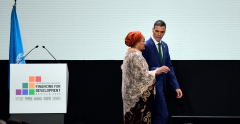If the world has had enough of helping others, then somebody forgot to tell Spain.
Yes, Spain. The same country that, a little more than a decade ago, desperately accepted billions in bailout money from its European neighbors to keep its economy afloat. That Spain is now doing something almost unthinkable. It’s ramping up aid spending just as the United States notoriously retreats. And in the process, Spain is trying to remind the world why we give back in the first place.
The US Agency for International Development (USAID) — the world’s largest humanitarian aid donor by far, whose work in recent years saved upward of a million lives per year — was officially dismantled earlier this month. Its scattered remains were subsumed by the State Department and its empty headquarters given to the FBI. But America isn’t the only one putting itself first these days. The UK, France, Belgium, and Germany all slashed their development budgets this year thanks to a wave of right-wing populism painting foreign aid as an unnecessary expense against the national interest.
The crisis is steep. The pot of money going to global development is set to shrink by 17 percent, or $35 billion, in 2025, on top of a $21 billion drop the year before, according to the Organization for Economic Cooperation and Development. That’s a $56 billion funding vacuum where global aid for mosquito nets, vaccine research, and food assistance used to be. And the declines are likely to become even steeper in the years ahead, as cuts in the US take full effect.
But while President Donald Trump was gutting USAID, Spain made moves to rebuild its aid agency and committed to more than doubling its aid budget by 2030. Nor is it alone: Ireland, South Korea, and Italy also all made recent pledges to boost their foreign aid budgets.
It’s far from enough to fill the foreign aid gap, however. And while the pain will fall primarily on impoverished recipient countries, foreign aid doesn’t just help the countries that receive it. It helps everyone.
Diseases and conflict don’t recognize legal borders and aid helps keep these deadly problems at bay. Every $100 million spent on preventing tuberculosis, HIV, and malaria helps prevent about 2.2 million new infections total. And global cuts are already expected to exacerbate the spread of diseases; former USAID officials anticipate cuts from the US alone could cause 28,000 new cases of infectious diseases like Ebola and Marburg each year. “Even if you’re in this isolationist mindset, you can’t actually isolate yourself from the rest of the world,” said Rachael Calleja, a research fellow at the Center for Global Development.
The fact that some countries have managed to fight the impulse to isolate — convincing their citizens that problems abroad are interconnected with our problems at home — could help reshape the future of aid for the better. Their decisions point to the possibility of a new future for foreign aid that could be more collaborative and less paternalistic than before.
Aid has long been dominated by a small club of wealthy nations — chief among them the United States, Germany, and the United Kingdom — that give the most, and in doing so, set the tone for how to help the rest of the world. Too often these well-intentioned solutions perpetuated the same exploitative power dynamics that made poor countries poor and one-time colonial powers like Spain and Italy rich in the first place. Western aid often comes with strings attached, like forcing Mali to privatize its cotton industry or requiring that funds be spent on consultants and supplies from the donor country — even though such policies have been shown to make aid less effective and much more expensive.
Ready or not, the old club’s grip on global influence is now breaking down.
”Nobody who works in development sat around saying, ‘The system is great. We’re awesome. Let’s just spend more money to do more of the same,’” said Dean Karlan, who was, until recently, the chief economist at USAID. “There is a blank slate. Let’s put in place a better system.”
Why are some countries bucking the trend?
Spain, Ireland, Italy, and South Korea are all increasing aid — but most have a lot of room for growth.
The United Nations set a lofty goal in the 1970s for wealthy countries to give away 0.7 percent of their gross national income (GNI) as development assistance. Half a century later, almost none do.
That includes this year’s overachievers. Ireland spent 0.57 percent of its GNI — $2.47 billion — on development aid last year. Spain spent 0.25 percent or $4.35 billion, and Italy, 0.28 percent or $6.67 billion. South Korea spent 0.21 percent or $3.94 billion.
It’s not a lot, especially compared to the $63.3 billion the US spent in 2024, although that only added up to 0.22 percent of its GNI. But these countries are moving forward at a time when everyone else seems to be moving backward. According to the global development consultancy SEEK Development’s donor tracker, the US is now projected to spend just 0.13 percent of its GNI on overseas aid this year.
There is a growing recognition that someone has to fill the gaps left by the US, but everybody balks at the price tag, Arturo Angulo Urarte, a Madrid-based development expert, said in Spanish. “It’s like, ‘Yes, but gosh, and how much does that mean? Oh, it means money? Well, then no.’”
Spain’s aid increase, however, has been a long time coming. Spanish activists launched a kind of Occupy Wall Street in favor of overseas aid back in the 1990s. A group of global development workers and grassroots activists staged hunger strikes and protest encampments, chaining themselves to government buildings to demand that Spain give at least 0.7 percent of its GNI to aid. At the time, Spain was giving around 0.24 percent of its GNI to aid, but the protests helped propel the country to double its commitment to a high of nearly 0.5 percent in 2008.
Then the 2008 economic turmoil left Spain once again with a wisp of an foreign aid budget. By the time its economy crawled closer to pre-crisis levels in 2015, its development spending had cratered to 0.12 percent of GNI.
But the idea of Spain becoming a bigger player in global development never really left the public consciousness, remaining broadly popular even during the country’s worst financial straits. In 2023 the country passed a law promising to rebuild its aid agency and bump up spending to 0.7 percent of GNI by 2030 — effectively tripling its current rate.
Spain has since increased its aid budget to about 0.25 percent of its GNI, or $4.4 billion last year — roughly $490 million more than it spent the year prior at 0.24 percent of its GNI — and says it will continue to give more in the year ahead. That’s more money for climate resilience projects in Morocco and Algeria, LGBTQ rights in Paraguay, and HPV vaccine campaigns across Latin America and the Caribbean.

The dismantling of USAID has destroyed longstanding and hard-won infrastructure for implementing aid programs, especially in critical areas like HIV prevention. There’s little that anyone can do to bring that infrastructure back, but countries like Spain, Ireland, or South Korea have been able to uplift and increase fund





